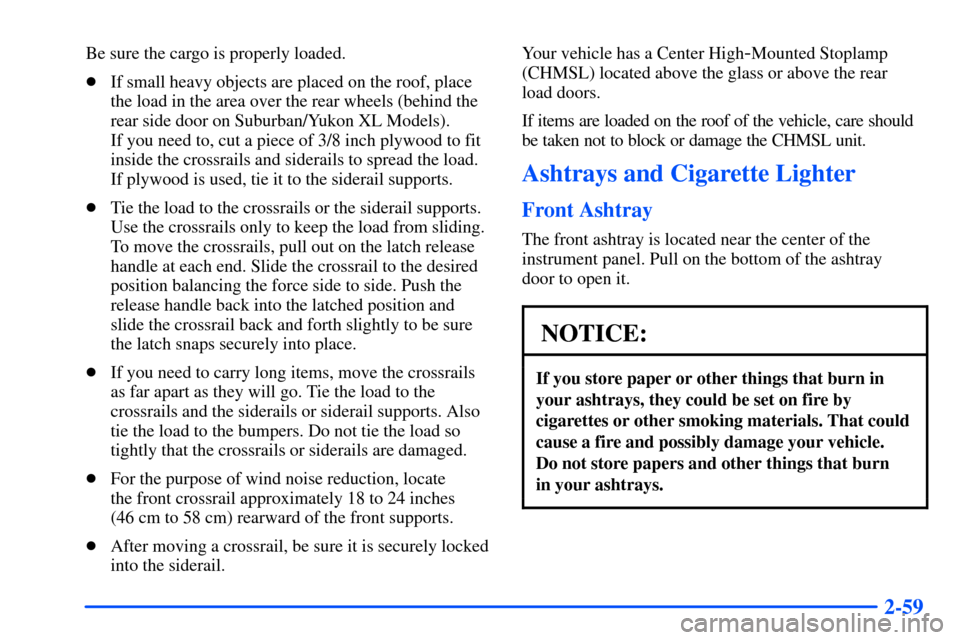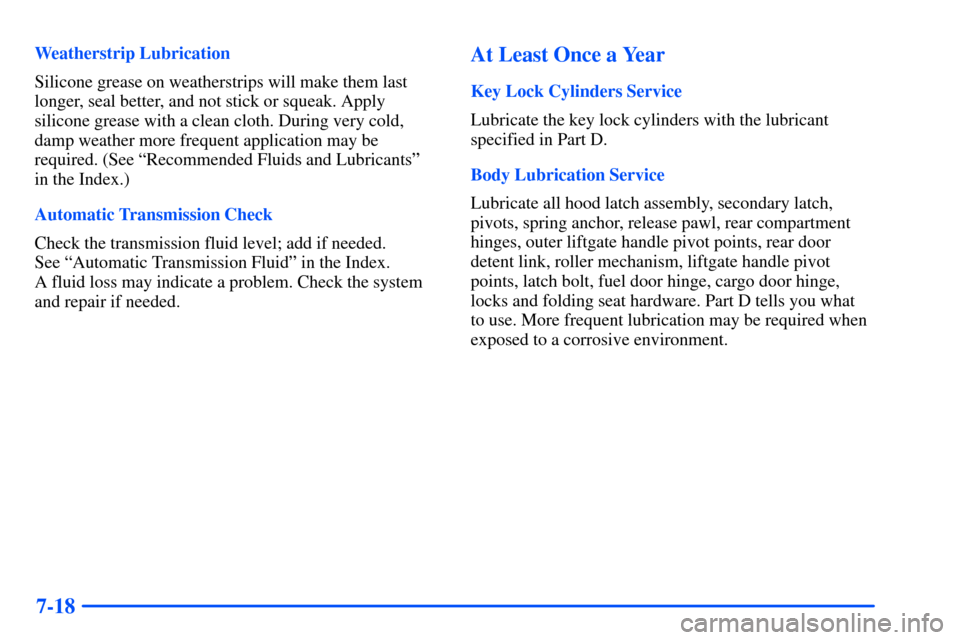Page 135 of 407

2-59
Be sure the cargo is properly loaded.
�If small heavy objects are placed on the roof, place
the load in the area over the rear wheels (behind the
rear side door on Suburban/Yukon XL Models).
If you need to, cut a piece of 3/8 inch plywood to fit
inside the crossrails and siderails to spread the load.
If plywood is used, tie it to the siderail supports.
�Tie the load to the crossrails or the siderail supports.
Use the crossrails only to keep the load from sliding.
To move the crossrails, pull out on the latch release
handle at each end. Slide the crossrail to the desired
position balancing the force side to side. Push the
release handle back into the latched position and
slide the crossrail back and forth slightly to be sure
the latch snaps securely into place.
�If you need to carry long items, move the crossrails
as far apart as they will go. Tie the load to the
crossrails and the siderails or siderail supports. Also
tie the load to the bumpers. Do not tie the load so
tightly that the crossrails or siderails are damaged.
�For the purpose of wind noise reduction, locate
the front crossrail approximately 18 to 24 inches
(46 cm to 58 cm) rearward of the front supports.
�After moving a crossrail, be sure it is securely locked
into the siderail.Your vehicle has a Center High-Mounted Stoplamp
(CHMSL) located above the glass or above the rear
load doors.
If items are loaded on the roof of the vehicle, care should
be taken not to block or damage the CHMSL unit.
Ashtrays and Cigarette Lighter
Front Ashtray
The front ashtray is located near the center of the
instrument panel. Pull on the bottom of the ashtray
door to open it.
NOTICE:
If you store paper or other things that burn in
your ashtrays, they could be set on fire by
cigarettes or other smoking materials. That could
cause a fire and possibly damage your vehicle.
Do not store papers and other things that burn
in your ashtrays.
Page 141 of 407

2-65
3. Return to the HomeLink Transmitter in your vehicle
and firmly press and release the HomeLink
Transmitter button you have already programmed for
two to three seconds. Press and release the button
again (you may need to do this step up to three times)
to make sure that the HomeLink Transmitter has been
trained to the garage door opener motor head unit.
Check that the training was successful. The motor
head unit indicator light should no longer be flashing.
The garage door opener should now recognize the
HomeLink Transmitter. You may either use the
HomeLink Transmitter or the hand
-held transmitter
to open the garage door.
If after following these instructions, you still have
problems training the garage door opener, call the
manufacturer of the unit at 1
-800-355-3515.
Erasing Channels
To erase all three programmed channels, hold down the
two outside buttons until the indicator light begins to
flash (after 20 seconds). Release both buttons.
Accessories
Accessories for the HomeLink� Transmitter are
available from the manufacturer of the unit. If you
would like additional information, please call
1
-800-355-3515.
OnStar� System (If Equipped)
OnStar is a vehicle communications service. The
following services are available through a subscription
with OnStar and are available 24 hours a day:
Emergency Services
�Automatic Notification of Air Bag Deployment
�Stolen
-Vehicle Tracking
�Roadside Assistance with Location
�Remote Diagnostics
�OnStar MED
-NET
�Accident Assist
Convenience Services
�Remote Door Unlock
�Route Support
�Concierge Services
�Ride Assist
A complete user's guide is provided with the OnStar
System. For more information, contact OnStar
1
-888-ONSTAR7.
Page 305 of 407
6-6
While refueling, hang the filler cap by the tether using
the hook located on the inside of the filler door.
To remove the cap, turn it slowly to the
left (counterclockwise).
CAUTION:
If you get gasoline on yourself and then
something ignites it, you could be badly burned.
Gasoline can spray out on you if you open the
fuel filler cap too quickly. This spray can happen
if your tank is nearly full, and is more likely in
hot weather. Open the fuel filler cap slowly and
wait for any ªhissº noise to stop. Then unscrew
the cap all the way.
Be careful not to spill gasoline. Clean gasoline from
painted surfaces as soon as possible. See ªCleaning the
Outside of Your Vehicleº in the Index.
Page 355 of 407
6-56
If you ever have a problem on the road and don't have
a spare fuse, you can borrow one that has the same
amperage. Just pick some feature of your vehicle that
you can get along without
-- like the radio or cigarette
lighter
-- and use its fuse, if it is the correct amperage.
Replace it as soon as you can.
Instrument Panel Fuse Block
The fuse block access door
is on the driver's side edge
of the instrument panel.
Pull off the cover to access
the fuse block.
You can remove fuses with a fuse extractor which is
mounted to the fuse block access door. To remove fuses
if you don't have a fuse extractor, hold the end of the
fuse between your thumb and index finger and pull
straight out.You may have spare fuses located behind the fuse block
access door. These can be used to replace a bad fuse.
However, make sure it is of the correct amperage.
NAME Usage
L BODY Retained Accessory Power Relay
LOCK Power Door Locks
DRV UNLOCK Power Door Lock Relay
Page 356 of 407
6-57
NAME Usage
LOCK Power Door Lock Relay
HVAC 1 Climate Control System
CRUISE Cruise Control, Instrument Cluster
IGN 3 Ignition, Power Seats
4WD Four
-Wheel Drive System,
Auxiliary Battery
CRANK Starting System
INT PRK Parking Lamps, Sidemarker
Lamps, Interior Lamps
L DOOR Power Door Lock Relay
BRAKE Anti
-Lock Brake System
RR WIPER Rear Window Wiper
ILLUM Interior Lamps
SEAT Power Seat Circuit Breaker
TURN Exterior Lamps, Turn Signals,
Hazard Lamps
UNLOCK Power Door LocksNAME Usage
HTR A/C Climate Control System
WS WPR Windshield Wipers
IGN 1 Ignition, Instrument Panel
AIR BAG Air Bag
MIR/LOCK Power Mirrors, Power Door Locks
DR LOCK Power Door Locks
PWR WDO Power Window Circuit Breaker
UNLOCK Power Door Lock Relay
IGN 0 PRND321 Display, Odometer,
VCM/PCM
SEO IGN Special Equipment Option,
Ignition
SEO ACCY Special Equipment Option
Accessory, Cellular Telephone
RAP #1 Retained Accessory Power Relay
RDO 1 Audio System
RAP #2 Rear Power Windows,
Sunroof, Radio
Page 360 of 407

6-61
Name Usage
STUD #1 Accessory Power/Trailer
Wiring Feed/Load Leveling
ABS Anti
-Lock Brakes
IGN A Ignition Switch
AIR A.I.R. System
RAP #1 Retained Accessory Power,
Power Mirrors, Power Door
Locks, Power Seat(s)
IGN B Ignition Switch
RAP #2 Retained Accessory Power/Rear
Power Windows, Sunroof, Radio
STUD #2 Accessory Power/Trailer Wiring
Brake Feed
TRL R TRN Right Turn Signal Trailer Wiring
TRL L TRN Left Turn Signal Trailer Wiring
IGN 1 Ignition, Fuel Controls
INJ B Ignition, Fuel Controls (Relay)
STARTER Starter (Relay)
PARK LP Parking LampsName Usage
FRT HVAC Climate Control System
STOP LP Exterior Lamps, Stoplamps
ECM 1 VCM/PCM
CHMSL Center High Mounted Stoplamp
VEH STOP Stoplamps, Cruise Control
TRL B/U Backup Lamps Trailer Wiring
INJ A Fuel Controls, Ignition
RR HVAC Rear HVAC
VEH B/U Vehicle Backup Lamps
ENG 1 Engine Controls, Canister Purge,
Fuel System
ETC Electronic Throttle Control
IGN E A/C Compressor Relay, Rear
Window Defogger, Daytime
Running Lamps, A.I.R. System
B/U LP Backup Lamps, Automatic
Transmission Shift Lock
Control System
ATC Automatic Transfer Case
Page 384 of 407

7-18
Weatherstrip Lubrication
Silicone grease on weatherstrips will make them last
longer, seal better, and not stick or squeak. Apply
silicone grease with a clean cloth. During very cold,
damp weather more frequent application may be
required. (See ªRecommended Fluids and Lubricantsº
in the Index.)
Automatic Transmission Check
Check the transmission fluid level; add if needed.
See ªAutomatic Transmission Fluidº in the Index.
A fluid loss may indicate a problem. Check the system
and repair if needed.At Least Once a Year
Key Lock Cylinders Service
Lubricate the key lock cylinders with the lubricant
specified in Part D.
Body Lubrication Service
Lubricate all hood latch assembly, secondary latch,
pivots, spring anchor, release pawl, rear compartment
hinges, outer liftgate handle pivot points, rear door
detent link, roller mechanism, liftgate handle pivot
points, latch bolt, fuel door hinge, cargo door hinge,
locks and folding seat hardware. Part D tells you what
to use. More frequent lubrication may be required when
exposed to a corrosive environment.